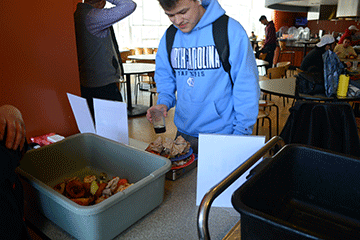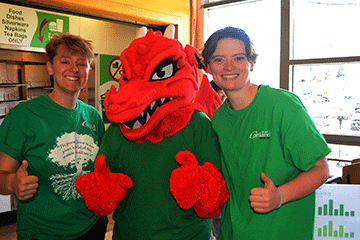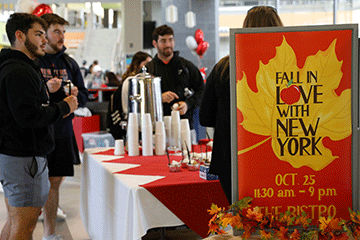
07/16/2024
Campus dining services around the country — including at SUNY Cortland — tried taking away trays a decade ago, when it seemed like a simple solution to the food waste created by college students whose eyes were bigger than their stomachs.
When that didn’t work, they tried shrinking the plates.
But it turns out that getting students to act for the sake of environmental sustainability and university fiscal responsibility takes a little extra ingenuity, according to Nichole Edwards, associate vice president of SUNY Cortland Auxiliary Services.
“An enormous amount of post-consumer waste is stuff people decided they didn’t want to eat because they took too much on their plate,” Edwards said.
According to the Food and Drug Administration, between 30 and 40% of America’s food supply is wasted and the Environmental Protection Agency calculates that each year, U.S. food loss and waste embodies air pollution equivalent to what is vented by 42 coal-fired power plants.
At SUNY Cortland, the dining services team recently earned national recognition for being among a handful of universities around the country that are running an operation that is trying to change that grim statistic one student at a time.
Cortland Auxiliary Services (CAS) in June was notified that it had won a bronze award in the Waste Reduction category of the 2024 NACUFS Sustainability Award, presented by the National Association of College and University Food Services (NACUFS). Cortland is number three in the country, tied with Boston College.

Cortland’s winning Waste Reduction entry focused on CAS’ multifaceted approach to greatly reducing the amount of food that gets thrown away.
One feature of Cortland’s program was a Weigh the Waste on Earth Day opportunity for the campus community to learn how they create around 70% of the discarded food known as “post-consumer waste.” On that day in 2023, students using the largest dining facility on campus, Neubig Hall, were encouraged to guess the weight and track it on social media, with each consumer receiving their own contribution and running total for the day's post-consumer waste.
“The thought is the next time you go through the line, you remember that and maybe you take one less scoop of pasta or one scoop, not two, of potato salad,” Edwards said. “But if you finish it all and it’s enough, then you’re not wasting it. It gives you a moment of reflection.”
Awareness and behavior changed, resulting in a before and after of 141.11 average pounds wasted before the event versus 79.8 average pounds wasted starting the next semester. A campus survey showed the program’s popularity with students.
“If it resonates with them and they can see the impact, then they can make that choice to be better about their selection,” Edwards said. “But it doesn’t create any obligation for them to make a change if they’re not ready to hear it or if they didn’t like the process.”
She noted that efforts to influence students to think about their consumption are thoughtful and time-consuming, as evidenced by the campus’ selection of a biodegradable straw after trial runs and thumbs down by the campus community on five prior paper sippers. Now, even the forks and knifes and spoons at campus grab-and-go eateries will break down into harmless organic material.
Staff members already carefully account for any food they burn, spill or otherwise cannot serve. Cooks for CAS daily weigh the pans of food they produce, less the weight of the pan, both freshly cooked and when discarding the uneaten remainder, Edwards noted. The data lets CAS employees work to reduce their own lost product in the form of expired, overproduced, spoiled and trimmed waste, each category amounting to 10% or less of the food waste stream, totaling roughly 30%.

“We practice something called ‘just in time’ cooking, so we know about how many customers we are going to have each day,” Edwards said, explaining the relative efficiency of Cortland’s food services. “Nobody wants to eat chicken that got cooked eight hours ago, so if it turns out to be a slower day, I will not have cooked and therefore wasted it. I can serve chicken in a different style the next day.”
Cortland uses metrics for New York state as well as the goals and benchmarks of NACUFS in deciding how best to accomplish sustainability. For example, by teaming up with the same company that hauls Wegman’s supermarket organic waste to a regional composting company, the university recycles its organic waste and goes well beyond what New York state requires of the more remote SUNY campuses.
“With our commitment with local partners toward a global future, we are trying to isolate some things we can do and be successful at in the ‘now,’ and then also look at the ‘up and coming’ so that we can place ourselves to be ready for the next trend here and the next opportunity without losing service,” Edwards said.
Healthy-themed special event wins bronze
The campus dining services team also earned a bronze award in the Residential Special Event category of the NACUFS’ hotly competitive 2024 Loyal E. Horton Dining Awards.
Cortland was recognized for an Oct. 15, 2023, New York state-grown apple-themed event titled Fall in Love with New York, posted on YouTube.
“SUNY Cortland participates in New York state’s Apple Crunch Day every year,” Edwards said. “We don’t pick the date but when we do get it, we kind of go into overdrive.”

In its seventh year, the event lets the campus community try every available apple variety as well as savor free samples of the many dishes made with the quintessentially New York state fruit, in the lobby beside the Student Life Center’s Bistro off Broadway and outdoors in good weather.
“New York is the apple empire, so we give them different apples and we usually get Cortlands in the mix,” Edwards said. “Students who haven’t been to a large farmer’s market can only identify about three kinds of apples, but now they know that there may be more than 80 varieties.
“Our production team enjoys really being creative,” Edwards said. “If we come to them with the theme, ‘We want you to use apples at the rotisserie station,’ they just come at it with a lot of enthusiasm. … And our customers love the treatment: ‘How about apple salsa on top of pork chops?’”